Ways to check the fishing rules for the Fiordland area
| Method | Link or more information |
| Find the rules on this page | Size and catch limits, closed areas, and restrictions |
|
Use the |
|
| Text us |
Text 9889 with the name of a species. |
| Download the brochure |
Fiordland fishing rules brochure [PDF, 2.1 MB] |
| Read signs |
Check and read any signs that are erected on the coast where you are fishing. |
About the Fiordland Marine Area
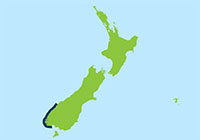
The Fiordland (Te Moana o Atawhenua) Marine Area is a special management area in the South-West of the South Island. It includes the Fiordland coastal marine area waters, commencing from Awarua Point on the West Coast of the South Island and extending 12 nautical miles seaward from the mean high-water springs mark along the Fiordland coast to its south-eastern boundary point at Sand Hill Point, but excludes the coastal marine area around the Solander Islands.
The Fiordland Marine Area includes the waters of the Fiords and are defined as:
- the Fiords
- the Internal Waters of Fiordland (Internal Waters)
- the Milford Sound (Piopiotahi) blue cod closure area.
The Fiords
The Fiords encompass all of the fiord waters, lying east of a defined fiord entrance line that extends across and between the respective fiord entrance outer headlands of 14 named fiords. The newly designated Fiords waters include the existing Internal Waters of Fiordland within each fiord.
The Fiords include:
- Milford Sound (Piopiotahi) waters lying east and inside a straight line from Saint Anne Point to Stripe Point,
- Bligh Sound (Hāwea),
- George Sound (Te Houhou),
- Caswell Sound (Taitetimu),
- Charles Sound (Taiporoporo),
- Nancy Sound (Hinenui),
- Thompson Sound (Te Awa-o-Tū) and Bradshaw Sound (Kaikieke),
- Doubtful Sound (Pātea),
- Dagg Sound (Te Rā),
- Breaksea Sound (Te Puaitaha),
- Dusky Sound (Tamatea),
- Chalky Inlet (Taiari),
- and Preservation Inlet (Rakituma).
Internal Waters of Fiordland
The Internal Waters of Fiordland are defined inner areas within the Fiords.
All commercial fishing is prohibited within the Internal Waters, which collectively encompass 46,000 hectares across 15 fiords, including Acheron Passage. Within this area, conservative recreational fishing catch limits, method restrictions and species take prohibitions can apply due to the inner fiord habitat being less productive and fish stocks less abundant.

Unlawful to accumulate finfish and shellfish
Accumulation refers to the aggregation and possession of daily fish catch in excess of more than one day’s legal possession entitlement for any person, which is unlawful in the Fiordland (Te Moana o Atawhenua) Marine Area, including the Fiords.
For the Fiordland Marine Area you cannot legally accumulate finfish and shellfish species, including pāua. This means you must not take or have in your possession more than one day’s legal entitlement of these fish species.
For rock lobster taken from the Fiordland Marine Area, there is a three-day accumulation maximum limit of 15 rock lobsters, with no more than 3 rock lobsters taken from the Milford Sound (Piopiotahi) Internal Waters.
Accumulation of rock lobsters beyond one daily limit of six rock lobsters is conditional on each individual fisher’s daily catch separation and container labelling provisions being complied with. (Refer rock lobster provisions).
Note that different fishing rules apply to the Southland area.
The rules
Finfish – size and bag limits
In the Fiordland Marine Area, there is a combined daily bag limit of 20 finfish* per fisher (excluding specified baitfish and freshwater eels) with no accumulation applying.
This means that you can have a combination of up to 20 of any finfish in total. For example, you could have 10 blue cod, 5 blue moki, and 5 trumpeter, as long as you have no more than 20 finfish in total.
There are also species with individual daily limits within the combined daily bag limit of 20 (Table 1). You must not exceed individual species limits. For example, there is a daily limit of 3 bluenose. This means you could have 3 bluenose, 7 blue cod, and 10 tarakihi making up a total of 20 fish for your combined daily bag limit.
The combined daily bag limit of 20 finfish includes all finfish caught outside the Fiords and within the Fiords (including the Internal Waters) where the combined finfish daily limit is 10 per person.
For the entire Fiordland Marine Area, there is no accumulation allowed beyond one day’s finfish species limit. This means you must not accumulate or have in your possession more than one daily species limit or combined finfish daily limit regardless of whether you are fishing across several days.
The Fiords
When fishing exclusively inside the Fiords, including the Internal Waters, there is a combined daily bag limit of 10 finfish* per fisher (excluding specified baitfish and freshwater eels) with no accumulation beyond one daily limit.
This means that you can have a combination of up to 10 of any finfish in total within the combined bag limit of 10 finfish (Table 1). Within this, you must not exceed any individual species limits.
Any fish taken from the Fiords must be included and counted together with any finfish taken outside the Fiords to comply with the Fiordland Marine Area combined daily bag limit of 20 finfish per person.
In addition, you can take a maximum of 50 of any combination of baitfish species (Table 3) and a maximum of 6 freshwater eels (Table 4).
Remember, there may be other specific rules in some areas. Check the "Closed areas and special restrictions" section on this page for more information.
* Finfish includes all species of finfish of the classes Agnatha, Chondrichthyes, and Osteichthyes, at any stage of their life history, whether living or dead.
Table 1: Individual finfish species daily limits within the combined bag limit
|
Finfish species |
Fiordland Marine Area (outside fiord coastal waters) |
The Fiords |
Minimum fish length (cm) |
|---|---|---|---|
|
Albacore tuna |
10 |
3 |
— |
|
Barracouta |
20 |
3 |
— |
|
Blue cod – excluding Milford Sound (Piopiotahi) blue cod closure area |
10 |
1 |
33 Landed whole or gutted only |
|
Blue cod – Milford Sound (Piopiotahi) blue cod closure area |
No take allowed
|
||
|
Blue moki |
5 |
1 |
40 |
|
Bluenose |
3 |
1 |
— |
|
Blue shark |
1 |
— |
|
|
Bronze whaler shark |
1 |
— |
|
|
Butterfish (Greenbone) |
4 |
2 |
35 |
|
Elephant fish |
5 |
— |
|
|
Flatfish (except sand flounder) |
5 |
2 |
25 |
|
Groper (Hāpuku)/Bass - (excluding Internal Waters) |
3 |
1 |
— |
|
Groper (Hāpuku)/Bass – Internal Waters closed to taking groper (Hāpuku)/ Bass. |
No take allowed | ||
|
Hammerhead shark |
1 |
— |
|
|
Hoki |
5 |
1 |
— |
|
Kahawai |
5 |
1 |
— |
|
Kingfish |
3 |
75 |
|
|
Ling |
5 |
1 |
— |
|
Mako shark |
1 |
— |
|
|
Marblefish |
5 |
1 |
— |
|
Marlin |
1 |
— |
|
|
Porbeagle shark |
1 |
— |
|
|
Quinnat salmon |
1 |
— |
|
|
Red cod |
5 |
2 |
25 |
|
Red gurnard |
5 |
2 |
25 |
|
Red moki |
5 |
40 |
|
|
Rig |
2 |
— |
|
|
Sand flounder |
5 |
2 |
23 |
|
School shark |
2 |
— |
|
|
Sea perch/Jock Stewart |
10 |
1 |
— |
|
Seven gilled shark |
1 |
— |
|
|
Skate/Ray |
1 |
— |
|
|
Snapper |
5 |
— |
|
|
Southern bluefin tuna |
1 |
— |
|
|
Spiny dogfish |
2 |
— |
|
|
Stargazer |
5 |
2 |
— |
|
Tarakihi |
10 |
1 |
25 |
|
Thresher shark |
1 |
— |
|
|
Trevally |
5 |
1 |
25 |
|
Trumpeter |
5 |
1 |
35 |
|
Warehou |
5 |
1 |
— |
|
Wrasse |
10 |
4 |
— |
|
Any other finfish (whether of the same or different species) for which a specific limit is not specified in this table but not including eels and baitfish |
10 |
4 |
— |
Table 2 - Additional to combined finfish daily bag limit
| Baitfish species | Maximum daily limit per active fisher |
|---|---|
|
Anchovy |
Daily limit of 50 for any combination of these species
|
|
Jack/Horse/Chilean mackerel |
|
|
Koheru/Scad |
|
|
Pilchard |
|
|
Piper/Garfish |
|
|
Slender/Stout sprat |
|
|
Yellow-eyed mullet |
Table 3 – Additional to combined finfish bag limit
| Finfish species | Maximum daily limit per active fisher | Min mesh size (mm) |
|---|---|---|
|
Freshwater shortfin and longfin eels |
6 |
12 |
Blue cod restrictions
| Restriction | Rule |
|---|---|
| Blue cod minimum size length |
Measure and immediately return any undersize blue cod less than 33cm length immediately to the water. It is unlawful to process and use undersize blue cod for bait.
Measure blue cod from the tip of the nose to the rear end of the middle ray of the tail fin as shown. |
|
Blue cod measurable State |
Within the South West blue cod management area, which includes the Fiordland Marine Area, all blue cod catch possessed in New Zealand fisheries waters on a vessel must be retained and landed either in a whole, or gutted measurable state (minimum length 33cm). It’s important to note, for blue cod ‘gutted’ means the removal of the abdominal cavity organs. When you ‘bleed’ blue cod, do not cut out the gills or severe the spine to compromise the measurable state, particularly for any fish close to 33cm minimum length. |
|
Eating processed state blue cod on the boat |
Recreational fishers on board a fishing vessel, may possess blue cod in a processed state, if it is to be immediately eaten on board the fishing vessel from which it was taken. Any blue cod that you eat must be counted towards your daily catch/bag limits. |
|
Possession of blue cod fillets on a boat in New Zealand fisheries waters |
If you possess filleted blue cod, other than for immediate meal consumption to retain on board a vessel, or you have filleted blue cod on shore to take home, you cannot possess processed blue cod fillets on a vessel, or take the fillets back on a vessel in New Zealand fisheries waters to transport in an unmeasurable state. |
|
No blue cod accumulation applies |
Within the Fiordland Marine Area, no accumulation applies for blue cod possession beyond one day's limit. Within the wider South West blue cod management area (excluding the Fiordland Marine Area), in the South Westland waters north of Awarua Point, when fishing over two or more days, you can possess up to a maximum of two times the daily bag limit for blue cod, contingent on fisher proof, including each individual fisher’s catch being separated and held in labelled containers to record the fisher’s name, date the fish was caught, and number of fish. |
|
Lowest blue cod limit |
When transiting from one blue cod management area to another, for example from the Southern area to the South West area and vice versa, or transiting from outside the 12 nautical mile Territorial Sea, fishers must observe and not exceed the lowest blue cod daily possession limit and applicable accumulation limit. Within the Fiordland Marine Area fishers can lawfully possess the legal South West area blue cod limit of up to 10 blue cod, taken from outside The Fiords, to transit inside and through the Fiords and the Internal Waters, where the lower take and possession limit applies. This also includes the Milford Sound (Piopiotahi) blue cod closure area. |
|
Milford Sound (Piopiotahi) blue cod closure area |
It is prohibited to take or possess blue cod taken from within the Internal Waters of Milford Sound (Piopiotahi) due to low abundance and poor habitat productivity. |
|
Blue cod pots prohibited |
It is prohibited to use or set any blue cod pot in the Internal Waters. |
|
Blue cod pots |
Blue cod pots can be used outside the Internal Waters in accordance with the following pot limit rules:
|
|
Blue cod pot limits |
Pot limits apply to all catching pots including both blue cod pots and rock lobster pots with pot possession and use restricted to:
|
|
Blue cod hook size |
The Fiordland Marine Guardians recommend the use of size 6/0 or larger, wide gap or circle fish hooks with no offset, to avoid damaging undersized blue cod and to improve juvenile fish survival. The advantage of using circle hooks is that fish are hooked in the front of the mouth, which are easier to unhook and avoids deep hook injuries from hooking the throat and gut. Only use one hook per rod or hand line, as the use of multi-hook rigs will lead to fish being poorly handled, reducing the chance of undersized fish surviving when released. |
Setline restrictions
Setline restrictions apply to all static line gear that is set in the water and not attached to a vessel in New Zealand fisheries waters. This includes longlines and dahn (drop) lines but does not include any rod and reel line or handline. Within the Fiordland Marine Area, including the Fiords and the Internal Waters, the following set-line fishing restrictions apply:
- surface floats attached to any setline must be legibly and permanently marked with the fisher’s surname and initials; the boat name is also useful.
- a maximum of 5 hooks per setline is allowed.
- a maximum of one setline per person may be used or set.
- if 2 or more people are on a vessel, no more than 2 setlines may be used or set from, or possessed, on board that vessel.
Note, do not use or set any setline inside the Internal Waters, which is closed to groper (Hāpuku)/ bass to conserve depleted stocks.
Set nets and drift nets prohibited
It is unlawful to recreationally use, set or possess any set net in the Fiordland Marine Area. It is also prohibited to use a drift net for fishing in any New Zealand fisheries waters.
Shellfish – size limits and catch/bag limits
Shellfish are considered "taken" (collected or harvested) when they cannot freely return to the water. For example, when you put them in a catch bag.
Remember, there may be other specific rules in some areas. Check the "Closed areas and restrictions" section on this page for more information.
|
Shellfish species |
Fiordland Marine Area (outside fiord coastal waters) |
The Fiords |
Minimum size (mm) |
|---|---|---|---|
|
Cockle |
20 |
none |
|
|
Kina (sea eggs) |
30 |
none |
|
|
Mussels |
10 |
none |
|
|
Oysters |
No take allowed | ||
|
Pāua |
5 |
2 |
125 |
|
Pāua |
2 |
80 |
|
|
Pipi |
20 |
none |
|
|
Scallops |
No take allowed | ||
|
All others (combined) • |
20 |
none |
|
No accumulation of shellfish, including pāua beyond one day’s daily maximum limit entitlement within the Fiordland Marine Area.
* Possession of Ordinary blackfoot pāua daily limit beyond the one day maximum 5 species limit cannot be accumulated with the Fiordland Marine Area. For the avoidance of doubt, any blackfoot pāua taken from inside the Fiords waters must be counted together with any blackfoot pāua that was taken outside the Fiords and are not additional to the maximum 5 blackfoot pāua species limit.
• This is a combined shellfish mixed-species bag limit, whether the same or different species. It applies to all shellfish species not specifically named above and includes all crabs, cat's eye, cook's turban, limpets, starfish, periwinkles, and freshwater crayfish (kōura).
Shellfish to be landed in a measurable state
All shellfish to which a minimum size restriction applies (including pāua):
- must be landed in the shell in a measurable state, and
- cannot be shucked or shelled seaward of the mean high-water mark. This includes transporting shellfish catch on the water.
How to measure shellfish

Scallop and dredge oyster prohibition
No person may take or take or possess any scallops or flat/dredge oysters taken from within the Fiordland Marine Area due to species low abundance.
Shellfish method restrictions
Underwater breathing apparatus
It is unlawful for any person to:
- take any pāua using underwater breathing apparatus (UBA), excluding snorkels
- It is unlawful for any person to be in possession of pāua while in possession of UBA. This includes possession in or on any vessel, aircraft (including helicopter) or vehicle.
Dredges prohibited
It is unlawful to use or possess any dredge in the Fiordland Marine Area.
Coral
It is prohibited to take or possess any black coral or red coral.
Rock lobster (crayfish) rules and limits
This section has the rules for both:
- spiny rock lobster
- packhorse rock lobster.
A maximum daily bag limit of 6 rock lobster (both spiny and packhorse rock lobster species combined) applies in the Fiordland Marine Area, including within the Fiords and the Internal Waters, but excluding the Milford Sound (Piopiotahi) Internal Waters which has a rock lobster limit of 3, with no accumulation.
| Rock lobster species |
Fiordland Marine Area |
The Fiords |
|---|---|---|
|
Spiny red rock lobster Packhorse rock lobster – both species combined. |
|
|
| Except Milford Sound Internal Waters rock lobster – both species combined. |
3 |
|
Remember, there may be other specific rules in some areas. Check the "Closed areas and special restrictions" section on this page for more information.
Rock lobster daily limit
Maximum of 6 rock lobster (both species combined) per day.
Maximum of 3 rock lobster (both species combined) taken from within the Milford Sound (Piopiotahi) Internal Waters. No accumulation applies.
There is a 3-day accumulation maximum limit of 15 rock lobsters, conditional on each individual fisher’s daily catch separation and container labelling provisions being complied with.
Limits on rock lobster accumulation
Within the Fiordland Marine Area a special regulation defence provision allows fishers to possess and accumulate rock lobsters taken over 3 or more days in excess of the daily possession limit if:
- not more than 15 rock lobsters are possessed
- the daily take limit of 6 rock lobsters was not exceeded on any day
- not more than 3 rock lobsters were taken from the Milford Sound (Piopiotahi) Internal Waters.
In the case of rock lobster held temporarily in a holding pot at sea
The fisher must maintain and be able to immediately produce upon the request of a fishery officer, a legible written record containing the following information:
- the individual fisher’s full name
- the date on which the fisher took the rock lobster
- the number of rock lobster held in each rock lobster holding pot, including the number of rock lobster taken from within the Milford Sound (Piopiotahi) Internal Waters
- the global positioning system (GPS) coordinates or physical location of each holding pot
- the date on which the fisher removed rock lobster from each holding pot
- the number of rock lobster removed from each holding pot.
In the case of rock lobster held on board or landed from a vessel
Including rock lobster removed from any holding pot, the rock lobsters are held in labelled containers or bags that:
- contain only rock lobsters taken on a single day
- are clearly labelled to record the:
- individual fisher’s full name
- date on which the rock lobster was taken by the fisher
- number of rock lobsters held in the container or bag
- number of rock lobsters (if any) taken from the Milford Sound (Piopiotahi) Internal Waters.
Note: Accumulation of rock lobsters beyond an individual fisher’s daily limit of 6 is conditional on each individual fisher’s daily catch separation and container labelling requirements being met.
Failure to comply with the regulation conditions, risks any accumulated rock lobsters beyond the 6 daily limit being confiscated and returned to the water by fishery officers, along with receiving an infringement notice for exceeding the rock lobster possession limit.
Spiny rock lobster minimum size
Measure spiny rock lobster tail width in a straight line, between the tips of the 2 large (primary) spines on the second segment of the tail.
- The minimum measurement for males is 54mm.
- The minimum measurement for females is 60mm.
- If you're not sure what sex the lobster is, use the 60mm measurement.
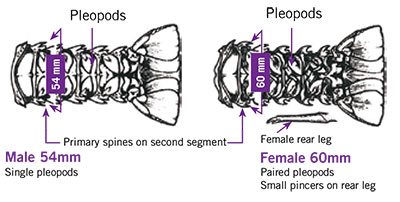
Packhorse rock lobster minimum size
New method (from 1 April 2024)
Measure packhorse rock lobster tail width in a straight line, between the tips of the 2 large (primary) spines on the second segment of the tail.
- The minimum measurement for males is 84mm.
- The minimum measurement for females is 90mm.
- If you're not sure what sex the lobster is, use the 90mm measurement.

Other rules and protections
There are rules for gathering rock lobster that cover:
- protected types
- banned gathering methods
- pot construction and use.
Protected types
Some types of rock lobster are protected. You must return them to the water straight away. Protected rock lobsters are:
- undersized rock lobster
- any female rock lobster carrying external eggs ("in berry") – these are carried on the underside of the tail
- any rock lobster in the soft shell stage
- any rock lobster that cannot be measured (for example, because of damage to the tail preventing accurate measurement). There are specific exemptions for very large rock lobsters with damaged tails. This applies to:
- Spiny rock lobsters that weigh 600g or more, or have a carapace (body) length of 110mm or more.
- Packhorse rock lobsters that weigh 2kg or more, or have a tail length of 216mm or more.
Prohibited gathering methods
When catching rock lobster, it is unlawful to:
- possess rock lobster or any rock lobster tail in an unmeasurable state seaward of the high-water mark.
- to remove external eggs or the egg bearing appendages from any rock lobster.
- use a spring-loaded loop or lasso – Only hand operated loop or lasso permitted.
- possess any punctured rock lobster that has been speared – Prohibited to use spears or puncturing devices – it is an offence to possess a speared rock lobster.
- use or set a baited net to take rock lobster and to possess any rock lobster taken with a baited net.
Rock Lobster pot limits
Rock lobster pot means any pot, baited or not, that is capable of catching or holding rock lobster. It includes any other device capable of catching, holding, or storing rock lobster except a loop, bob or ring pot.
Within the Fiordland Marine Area the following pot limits apply:
- All pots, and surface buoys or floats attached to the pot and float line, must be legibly and permanently marked with the person’s initials and surname. This includes possession on any vessel.
- An individual may use, set or possess up to 3 rock lobster (catching) pots in any one day.
- If 2 or more persons are on a vessel in the Fiordland Marine Area, the maximum vessel rock lobster catching pot limit is 3 pots within a 6 pots vessel limit; being any lawful combination of species specific catching pots and including blue cod pots and no more than 3 rock lobster catching pots and up to 2 rock lobster holding pots.
Rock lobster holding pots
A rock lobster holding pot is a pot that is used, or can be used, for holding or storing rock lobster but does not include any pot that is capable of catching rock lobster. Within the Fiordland Marine Area, specific provision allows the use of rock lobster holding pots in addition to rock lobster catching pots. Holding pots are excluded from other rock lobster pot limits and escape gap requirements. The following restrictions apply:
- a limit of one holding pot per person or a maximum of 2 holding pots per vessel if there are 2 or more persons on board
- holding pots and attached surface floats used from or transported on a vessel must be clearly and permanently marked with the vessel name and the characters HP1 for the first holding pot and (if applicable) HP2 for the second holding pot
- holding pots and attached surface floats used other than from a vessel must be clearly and permanently marked with the fisher’s surname, initials, and the characters HP.
Visit our rock lobster page for information on pot construction, escape gaps and use
Closed areas and special restrictions
The lists below show areas where:
- fishing is prohibited (closed areas) or restricted.
- special restrictions apply such as species take prohibitions and catch limits might be different (special restrictions).
There's more information in the rule's brochure and NZ Fishing Rules app.
Closed areas
Closed areas include:
- Marine Reserves
- Milford Sound (Piopiotahi) Internal Waters – blue cod closure area.
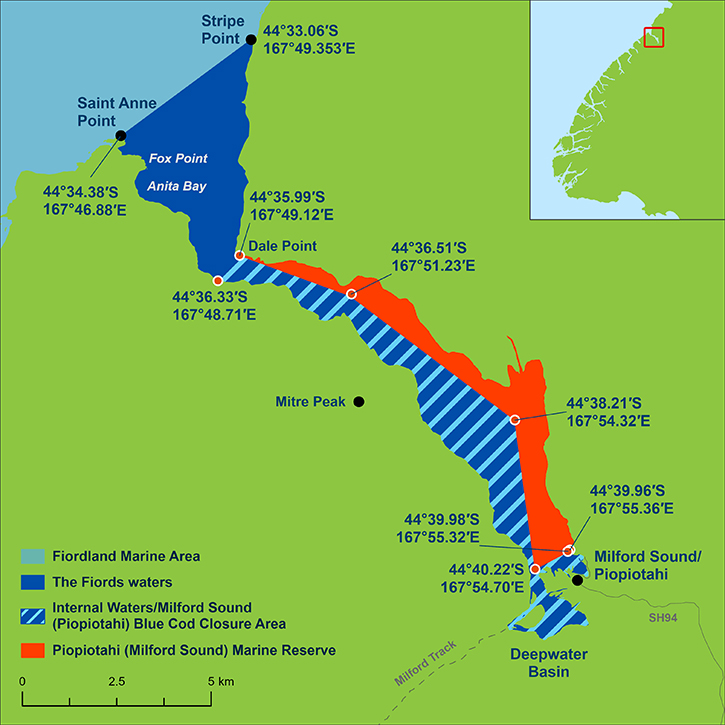
Marine reserves
In the Fiordland Marine Area there are 10 marine reserves administered by the Department of Conservation, which are closed to all fishing (shown in on the map below). Within the marine reserves, all marine life is fully protected, with all fishing both non-commercial and commercial totally prohibited.
- Piopiotahi (Milford Sound) Marine Reserve.
- Te Hāpua (Sutherland Sound) Marine Reserve.
- Hāwea (Clio Rocks) Marine Reserve (Bligh Sound).
- Kahukura (Gold Arm) Marine Reserve (Charles Sound).
- Kutu Parera (Gaer Arm) Marine Reserve (Bradshaw Sound).
- Te Awaatu Channel (The Gut) Marine Reserve (Doubtful Sound).
- Taipari Roa (Elizabeth Island) Marine Reserve (Doubtful Sound).
- Moana Uta (Wet Jacket Arm) Marine Reserve (Acheron Passage).
- Taumoana (Five Fingers Peninsula) Marine Reserve (Dusky Sound).
- Te Tapuwae o Hua (Long Sound) Marine Reserve (Preservation Inlet).
Marine reserves are managed by the Department of Conservation (DOC).

A to Z of marine reserves – DOC
Restricted areas
Restricted areas are areas where the use of a particular fishing method (for example, set nets or pots) is prohibited or restricted, or where fish species catch limits may be different.
Internal Waters and Fiord Waters Boundaries
The Fiord waters have lower limits for fish and shellfish and a reduced combined bag limit of 10 finfish.
The take of hapuku/grouper is prohibited in the internal waters of Fiordland.
The use of blue cod pots is prohibited in the internal waters of Fiordland.
Piopioahi/Milford Sound

Te Hāpua/Sutherland, Hāwea/Blight and Te Houhou/ George Sounds

Taitetimu/ Caswell, Taiporoporo/ Charles and Hinenui/ Nancy Sounds

Patea/Doubtful Sound Complex and Te Rā/ Dagg Sound
Pendulo Reach (Doubtful Sound/Patea) prohibited potting area.
It is unlawful to set or use any rock lobster pot or any holding pot within the Doubtful Sound/Patea Internal Waters known as Pendulo Reach (as shown on the map). This is to protect fragile seabed species and sensitive bottom sill habitat.
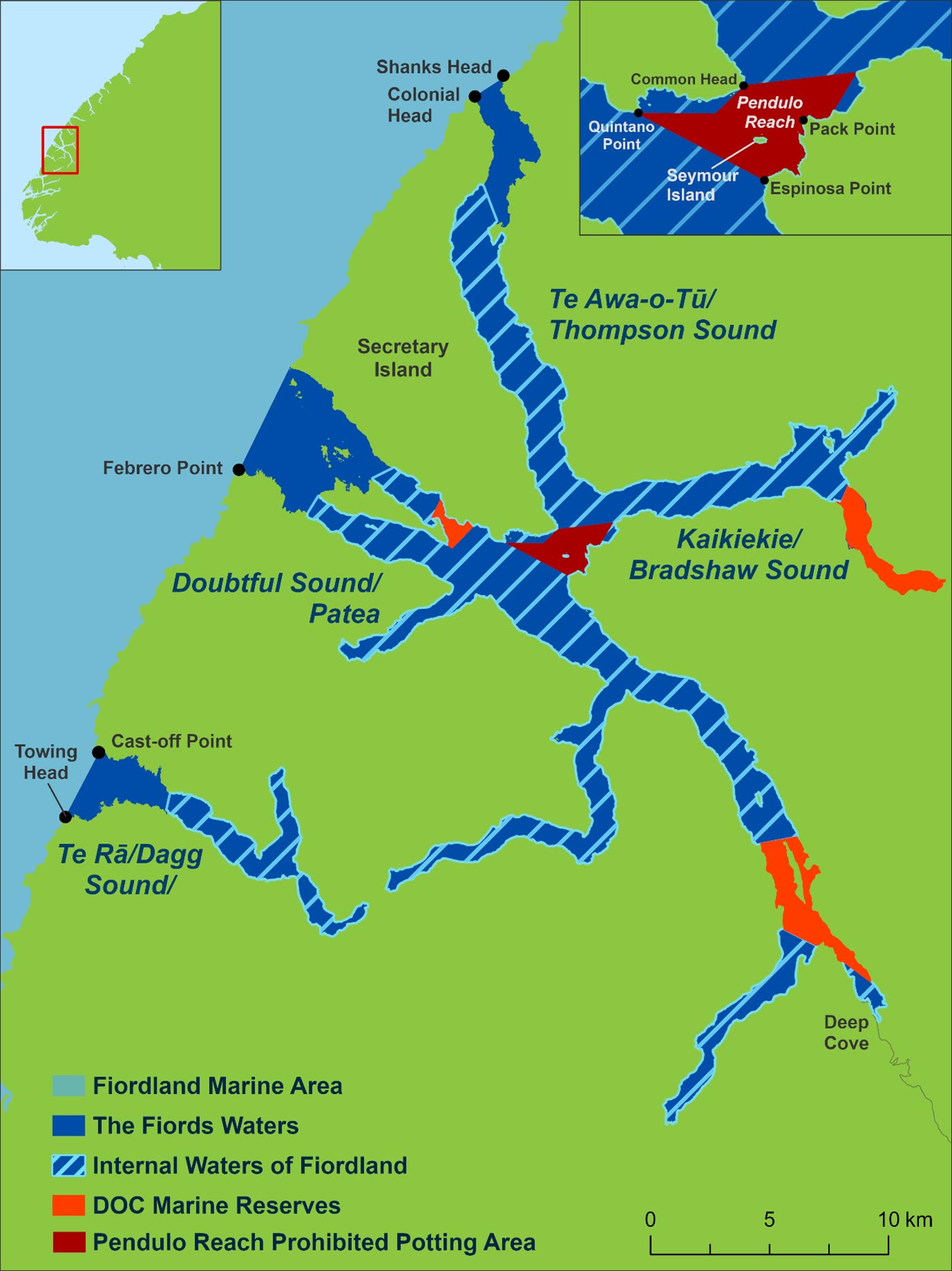
Te Puaitaha/Breaksea and Tamatea/Dusky Sounds

Taiari/Chalky and Rakituma/Preservation Inlets

Mātaitai reserves
Mātaitai reserves are established over traditional Māori fishing grounds to allow for customary seafood gathering and sustainable management of the area/ rohe moana by appointed Tāngata Tiaki/ Kaitiaki (Guardians). All commercial fishing is prohibited unless specifically allowed and fishing bylaw prohibitions and restrictions may apply to recreational fishing.
Waitutu Mātaitai Reserve
The Waitutu Mātaitai Reserve, which was declared in June 2014 is located on the south Fiordland coast, situated midway between and east of Long Point and west of Sand Hill Point and borders Waitutu Incorporation SILNA land.
The Waitutu Mātaitai Reserve encompasses approximately 2.08 sq km bounded between the western side of the Wairaurahiri River mouth and the eastern side of the Crombie Stream mouth and extending seaward 450 metres (0.24 of a nautical mile) from the mean high-water mark.
- All commercial fishing is totally prohibited within the mātaitai reserve.
- All recreational pāua fishing is totally prohibited within the mātaitai reserve.
View the map [JPG, 2.4 MB]
Fisheries (Declaration of Waitutu Mātaitai Reserve Bylaw) Notice 2015 [PDF, 28 KB]
Set Netting Prohibited in the Fiordland Marine Area
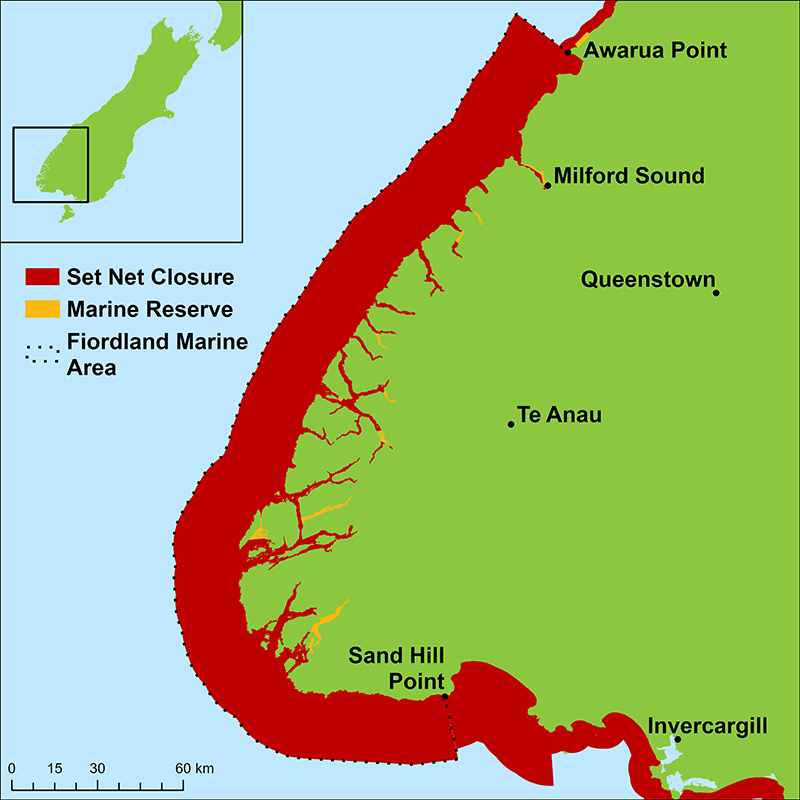
Report poaching
You can report poaching, suspicious, or illegal activity online:
Report illegal fishing (such as poaching)
You can also:
- call 0800 4 POACHER (0800 47 62 24), or
- email poacher@mpi.govt.nz
You can help us by providing:
- the location
- vehicle/trailer registration number
- boat name
- description of the person.
When reporting any suspected poaching put your personal safety first. All calls and personal details are treated as confidential.
It is illegal to buy, sell, or swap recreationally caught seafood
These are offences against the Fisheries Act which can result in fines up to $250,000.
Fisheries offices
A list of Fisheries New Zealand offices
Follow us on Facebook
Our regional Facebook pages bring you information about the fishing rules and how we manage and protect local fisheries:
- Northland
- Auckland
- Bay of Plenty/Coromandel/Waikato
- Gisborne/Whakatane/Rotorua
- Nelson/West Coast
- Marlborough/Canterbury
- Otago/Southland
The regulations
Fisheries (Amateur Fishing) Regulations 2013 – NZ Legislation
Who to contact
If you have questions about Fiordland area fishing rules, email info@mpi.govt.nz









